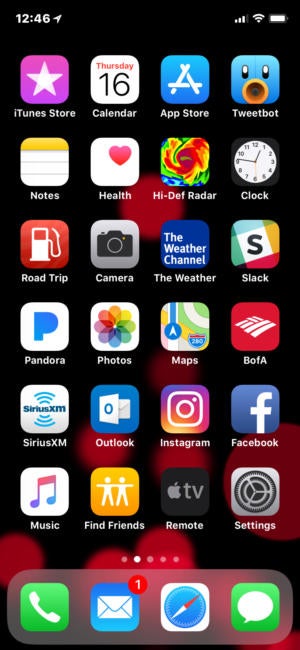Review: The iPhone X is the best phone for business, period.
Apple's new iPhone X sets the scene for the next decade of iPhone development with a host of futuristic technologies. While expensive, it is the best smartphone available today.
- The role of iOS 11
- What’s new in the iPhone X?
- Using Face ID
- The best OLED display ever
- The A11 chip: Performance to match the display
- Qi-based wireless charging
- Better cameras, front and back
- Final thoughts
The display is packed with technology designed to make staring at it easier on the eyes, including True Tone, Night Shift (for night-time use), the 120Hz touch layer (for incredibly smooth reaction to screen presses and gestures), and technology to minimize long-term burn-in — something all OLED screens are susceptible to.
 Ken Mingis
Ken Mingis
The iPhone X's OLED display got an A+ rating from DisplayMate for its color calibration and performance.
True Tone uses a built-in six-channel ambient light sensor to adjust the white balance of the display, based on the determined color temperature of the light in the room. This is to emulate the characteristics of a sheet of paper, helping to reduce eye strain. Night Shift changes the display’s white point at sunset (by default) and resets it to normal at sunrise. (You can set a custom schedule or disable this entirely.) This is to reduce the amount of blue light your eyes absorb, which could, ultimately, affect your sleep cycle.
One issue with the iPhone X’s display that I did notice is that there is a slight color shift when its viewed at angles. That surprised me. Previous iPhones with TFT LCDs had perfected color consistency at angles; the X has a noticeable shift. DisplayMate says that the iPhone X’s display has the smallest brightness variation at a viewing angle for an OLED; I’ll take their word for it. Even so, the display is gorgeous.
One improvement I hope to see in a future iPhone is a 120Hz refresh rate for the display. Currently, the touch sensor ramps to 120Hz, leading to smooth animations at 60fps. But text still blurs when scrolling through documents or web articles because screen refresh rate is still 60Hz. Doubling that would allow for readable text when scrolling.
Apple already has this technology on the iPads; it’s called Pro Motion, and scrolling through text on that device allows text to remain legible. The next iPhone needs this.
The A11 chip: Performance to match the display
This year’s iPhones use Apple’s custom six-core 64-bit A11 “Bionic” chipset, with an M11 motion coprocessor (for tracking sensor measurements and for constant listening for the “Hey Siri” trigger) and a new Neural engine. The Neural engine is a dedicated component specifically designed for processing machine-learning calculations, such as identifying objects, places and people in pictures. It also powers Face ID and Animoji and contains the Secure Enclave. The Secure Enclave is an encrypted portion of the chipset dedicated to storing depth map and infrared image data specifically for Face ID authentication. That allows all biometric data used in the system to remain only on the device.
The A11 Bionic chipset has four high-efficiency cores running 70% faster than the ones in iPhone 7 series and two high-performance cores that are 25% faster than the iPhone 7. Unlike the A10 chip, which could use either the high-efficiency cores or the high-powered cores at a time, the A11 can use all six cores at the same time when apps need more processing power.
The Bionic chipset also includes the first Apple-designed GPU, which is up to 30% faster than previous generations. It’s tuned for Metal 2 and Core ML, yielding better graphics response times.
How powerful is the A11 Bionic? In some cases, benchmarks have it on par with Intel’s Core i5-7267U, the CPU found in the 13-in. MacBook Pro. In real world use, the iPhone X is extremely responsive, but it’s not just because of the faster six-core design. It’s because Apple writes its own software and it can be optimized to take advantage of the custom hardware. For instance, when you’re taking photos, images are analyzed instantaneously for better results with less noise. And for Face ID (or the Animojis), the Neural engine calculates image processing for people/object/location detection.
That’s 600 billion operations per second that the main CPU-cores don’t have to process, freeing them up for other tasks. The six-core chipset uses built-in iOS technologies to determine which cores — some or all of them — should be used, depending on the task at hand. These kinds of device-specific customizations are the result of years of work by Apple’s hardware and software groups. Working together, they can boost efficiency and offer performance that doesn’t come at the expense of battery life.
Qi-based wireless charging
While not specific to the iPhone X — the iPhone 8 and 8+ have it, too — wireless charging represents another step into the future by Apple. The Qi-based system requires little more than a wireless charging base, which are available at a range of prices. (Apple showcases two such chargers: one from Mophie, one from Belkin, both on the higher-priced end of the spectrum. It also plans to release its own charging pad in 2018.)
 IDG/Ken Mingis
IDG/Ken Mingis
An iPhone 8 being charged atop a wireless charger from RavPower, which can transmit up to 7.5W of power.
Wireless charging has been available in some Android phones for several years, so Apple is tardy to this particular technology. But it does offer a new level of convenience and comes at a time when wireless charging plates are even being included in some new cars and found in public locations like airports and restaurants.
Though the Qi-based system allows for up to 15 watts of wireless charging, the iPhones can only be charged at 5W. That will rise to 7.5W when iOS 11.2 rolls out. This will give you a little more juice (literally, a few extra percentage points) compared to charging the same phone running iOS 11.1. Until this technology evolves, the Lightning connector isn’t going anywhere; despite the convenience wireless charging brings, data transfers and battery charging are still much faster when the iPhone is physically plugged in.
Better cameras, front and back
iPhone users can always depend on Apple delivering a camera system capable of taking great shots, and this year is no different. The iPhone X comes with 12-megapixel wide-angle and telephoto lenses, with 1.8 and 2.4 f-stops, respectively, as well as dual image stabilization. This results in better, sharper low-light shots and smoother videos.
 Ken Mingis
Ken Mingis
A photo taken with the iPhone X's rear camera, a 12mp setup with two lenses and dual image stabilization.
The front camera has received an upgrade, as well, and now features the True Depth camera system for Face ID and Animojis. Both camera systems use the built-in hardware to identify depth in images, which can be used for a more advanced Portrait mode with Lighting effects. The results simulate DSL depth-of-field shots, and the lighting effect filters are capable of producing great shots — and not-so-great shots. (Depth data is saved so Portrait and Lighting modes can be edited or removed post-shot.)
As for video, the cameras can now shoot up to 60fps 4K video, as well as slow-motion footage at 240fps at 1080p. Just remember that the camera will deliver better results in these cases with lots of light, especially for slow-motion video.
The high-resolution cameras aren’t used only for taking photos, augmented reality, scanning QR codes or making Animojis. Using the built-in Notes app, it’s possible to “import” documents into your iPhone. Let’s say you need to sign a document and deliver it to someone; you can do that instantly by using Notes to scan the document, Markup to sign the areas that need signing, and then email to send the results to the recipient.
Final thoughts
When looking at the wealth of smartphone options now available on the market in either the IOS or Android ecosystems, there are many factors to consider, including reliability, security, hardware quality and longevity, software support (both feature-specific and security-related), management and deployment, as well as the availability of third-party hardware and software support.
With the iPhone X — assuming you’re already part of the Apple ecosystem — the biggest factor may be cost. Though the 64GB model just squeezes in under the $1,000 mark, the 256GB model will cost $1,149. Add in another $199 for Apple Care, which you really should buy given the cost of repairs. (Most smart companies do this as part of the buying process already.)
Add it all up, and that’s $1,348 for the top-end iPhone X, before taxes.
For that admittedly high price, you get the latest technology, whether it’s more convenient authentication with Face ID, a top-notch OLED screen, markedly improved cameras, Qi-based wireless charging, and a host of less-obvious features tied to iOS 11 — including an unmatched privacy policy and years of consistent feature and security updates.
The technologies introduced in this model are truly significant, and will make their way into future iPhones as well as influence and affect other Apple products, including the iPad and Mac line. Because that’s what the iPhone X is: the first part of the next evolution of the iPhone design.
It’s quite clearly the best smartphone on the market.
Copyright © 2017 IDG Communications, Inc.





